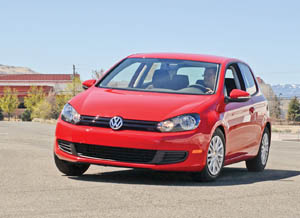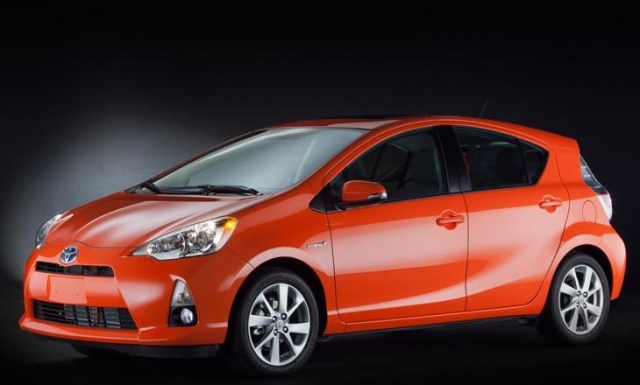Only a decade ago, we who prefer to look down on the vulgarians could enter the nearest car dealership and reliably find something to snicker at. Women with $300 shoes and tiny, annoying dogs flooded dealerships in order to buy Cadillac and Lexus SUVs that combined the efficiency of oil field fires with the road manners of enraged wasps. Men with tribal tattoos threw money at Dodge, Ford and Chevrolet because they wanted to commute from suburbia to urbia in the largest truck available. Fashion crushed function under boot, gasoline cost near nothing and profit-taking beat automotive design into a bloody mess behind the dumpster.
2014 is much better for car buying, though perhaps not so good for the vulgarians. Behold three affordable paths to comfortable, handsome transport. All achieve at least 40 highway mpg. All are practical enough to serve a family. One is even fun to drive.
Hyundai Accent
Base Price $12,545; Price as tested $16,100; EPA MPG 30 city/40 highway; 138 hp
Cars must go, stop and turn. They should carry you and your passengers in comfort. In all of these core competencies, the Accent performs admirably. It is remarkably spacious. Two generously proportioned gentlemen could share the back seat in complete serenity. Indeed, the Accent’s large dimensions allowed me to remain blissfully unaware of the salesman’s preference in antiperspirant. Lots of room in the front as well—my partner in testing, Gina Akao, flopped great distances to and fro whenever I drove vigorously.
All the controls fall naturally to hand, everything seems well-built, and it’s the easiest to drive car in our test. The six-speed automatic transmission slushes smoothly and responds to manual inputs within half a second or so. I would rate it as only moderately depressing, which is good for an automatic. It has the best, most natural-to-use brakes in our test, and it wasn’t particularly close. The Accent is a pretty striking thing as econoboxes go, all swoops and curves and adventurous detailing. The Accent also undercuts the next cheapest car in this test by almost ten grand, so it’s excellent value.
But here the clouds of boredom come to blot out some of Hyundai’s sunshine. Our test car came with special low rolling resistance, 14 inch tires. These nasty, rock hard things are supposed to save gasoline, and I’m sure they do. But, for that extra .2 mpg, the driver suffers a cacophony of road noise—concrete in G-minor, allegro of expansion joint. Thank heaven there’s a good sound system to drown it out. These tires also make the act of cornering as squishy and imprecise as drunken hippo sex. That’s a shame because the chassis seems capable. Add in our test car’s sexy, Italian Racing Brown bodywork and automatic gearbox, and the Accent does an excellent job inspiring narcolepsy in all who drive it.
Bad luck really, because I think this car could be a lot better with different options. Get rid of the joy-sucking automatic transmission – the stick is $900 cheaper in any case – and I’ll bet the acceleration goes from adequate to frisky. Spec the 16-inch sport wheels and tires instead of the 14-inch donuts of gloom and I’ll bet the car actually becomes kind of fun. Shame we got none of that.
Toyota Prius C
Base price $18,950; Price as tested $25,700; EPA MPG 53 city/46 highway; 99 hp
Neither Gina nor I have ever driven any car as weird as the Prius C. In fact, we might be more accurate to describe it as a spaceship from the planet Zardoz.
First the good news. Since Zardoz is a planet inhabited by heavily armed fashion designers, the Prius C looks aggressive, high tech and sleek, especially in orange. From the front, it has a scrunched nose and angry frown, like somebody just stole its protoplasmic nutrition money. The spaceship almost crouches on its front wheels, ready to devour any earthling foolish enough to touch its hybrid badges. Saving the environment evidently involves a lot of pent up angst, and I like that.
Upon entering, the exterior’s vitriol melts away into a Prada-meets-the-Borg orgy of tech modernism. The instrument cluster is a flatscreen display. To the right, another computer screen does many things, a few of which mere humans can, with sufficient brain exercises and years of training, apparently understand. Below this resides yet another computer screen where the driver may link to satellite radio, stock quotes, MP3 players, smart phones, Pandora and the launching system for Zardoz’s nuclear arsenal. You may not, however, link to your favorite FM radio stations without an hour’s searching.
All these computers mount to an angular dash covered in a material I’ll describe as Zardozian lizard scrotum. It’s pleasant to touch and looks nice—hundreds of perforations, lines and textures, refreshingly few hairs. The spaceship uses nothing so vulgar as a key, and so the owner is likely to leave the door-opening computer chip inside the car at least once daily.
Select drive and there’s more good news. The Prius C rides very smoothly. As long as we proceed very, very conservatively, it is a wonderful thing to be a passenger in, though also the most cramped car we sampled.
If you wish to drive the Prius C like a normal car, however, there’s a lot of bad news.
The steering is awful. The car sort of goes where you point, but the effort required to turn the wheel varies at random. During one roundabout, the effort required to maintain course ranged from fingertip light to “I hope you’ve been bench pressing” and back at least three times. Throttle response is even worse. Sometimes pressing on the gas makes a lot of noise with no progress. Sometimes it accelerates in silence. Sometimes the spaceship makes a lot of very unpleasant noise and then wheezes down the road. Just for variety, it will also silently move away when the driver does nothing. These shenanigans caused a minimum of three lurches per stop light.
Even those ills pale in comparison to the brakes. Press on the pedal with moderate force, and at first nothing happens. Wait a second longer, and suddenly the brakes bite with savage force. Then, at about 10 mph, the car reverts to glide mode. You must initially mash the brake pedal, ease up and then mash it again to stop smoothly.
I drove it briefly in a sporting manner. This caused Gina to call out in terror. I, too, feared for my life and not because it’s fast. The other two would blow it into the weeds. Our heavily optioned Prius C is also most expensive of the three. Rebates? Child, please.
Think of it as the bizzaro-Hyundai. Where the Accent blandly goes about its business, doing everything with great competence but no exuberance, the Prius endlessly entertains. It’s one of the most exciting cars I’ve driven, in no small part because it’s scary. It’s also hugely flawed. Gina sums it up best: “I like it and it’s very exciting, but that’s because I never know what it’s going to do next.”
Volkswagen Golf TDI
Base price $24,235; Price as tested $25,200; EPA MPG 30 city/42 highway; 140 hp
This is the best car we tried by miles. If the Hyundai is white bread served with a side of bland sauce and the Prius C a slightly psychotic spaceship, then the Golf is Joe Montana, a top athlete settling into respectable middle age.
It’s faster than the Accent and so much faster than the Prius it feels like getting off an asthmatic donkey and into a fighter jet. The 2.0 liter turbo diesel engine makes almost twice the torque of the other two and allows the driver to shoot out of corners at near sports car pace. With sharp, precise steering and an adjustable chassis, the Golf is an absolute pleasure to punt down a twisting road. Want to drive cleanly? No problem. Want to make the back tires slide a little? Certainly, sir. Want to get crazy like you’re auditioning for a Lady Gaga music video? It lives to serve.
The interior is even better. Gina, running her hands over the dash, headliner and seats, kept saying, “Ooh, that’s nice.” All the switches feel like they’ve been cut from solid blocks of aluminum. Turn signal indicators make satisfying, muted “clunk” sounds when you push them. The six-speed manual gear box snicks between ratios quickly and effortlessly, like an expensive knife through sashimi. The entire interior feels grown up, classy and confident. It’s also dead quiet and ultra smooth—85 mph in fourth gear without noticing smooth. It rides perhaps a touch harder than the spaceship but never jars. In terms of refinement, it almost feels unfair to compare it with the other two.
There are some minor annoyances. For example, putting on the seat belt requires dislocating one’s shoulder and there’s enough turbo lag to dislocate your concentration. The brake pedal has an inch of dead squish before biting down which makes heel-and-toe kind of a pain. Any time you stall the car, you must turn the ignition all the way off, all the way back on and wait for a split second to restart the engine. I discovered this in the middle of a busy intersection, which was very exciting. Finally, it feels expensive largely because it is expensive. If this all sounds like nitpicking, though, it is.
Golden Wisdom
These cars represent three different approaches to eco-friendly personal transportation. The conventional gasoline-powered Hyundai gives up very little efficiency to its hybrid and diesel competitors. It’s the most practical, the best value and effectively half the price of the others. It also has the best warranty. You cannot buy any new hybrid or diesel for similar money. Hyundai offers two other gasoline models, the sporty Veloster and the more powerful Elantra, that also achieve an EPA-rated 40 mpg for under $20,000. Ford, Chevrolet, Nissan, Kia, Honda and Mazda can make similar boasts. The conventional gasoline automobile is far from obsolete.
The Prius C is odd and, during our test drive, managed only 41 mpg. It is the least competent, but also the most intriguing in a science fiction sort of way. It’s kind of a shame we weren’t able to sample the full-size Prius, which supposedly has new generation (and vastly superior) brakes, drivetrain and steering components. Regardless, it was a blast. I never thought I’d be trying to justify a hybrid on the grounds of fun, but here we are.
Then there’s the overdog. The diesel Golf we drove was simply wonderful. If you go Golf, you will soon discover why diesel is so popular in Europe and Asia. Great performance, quiet cruising, refined highway manners, fun and practicality – the Golf was a Dom Perignon among box wines and priced to match.
Wanna Really Help the Environment? Mothball Your Truck.
The miles per gallon statistic is actually kind of deceptive. You would think, for example, that getting out of your 10 mpg truck and into a 20 mpg full size sedan would have an equal impact as selling your 30 mpg sub-compact and buying a 40 mpg fuel miser. You’d be mistaken and the reason has to do with consumption rates.
Let’s start with your giant, 10 mpg truck. Assume you drive 100 miles on your commute and therefore consume 10 gallons of fuel per day. At $4 per gallon that’s $40 in fuel to complete your trip. Now, assume you trade that truck for a powerful sports car like a Chevrolet Corvette. The Corvette gets about 25 mpg, which is neither great nor awful. For that same 100 mile commute you are now consuming only four gallons and $16 dollars of gasoline, saving six gallons and $24 compared to the truck.
Next you trade your Corvette for an Accent, Prius C (remember, we observed 41 mpg on our Prius’ trip computer) or Golf TDI. At 40 mpg, your commute consumes 2.5 gallons and $10. Compared to the Corvette, hardly an ecomobile, you have saved only 1.5 gallons and $6. Going from the Prius’ observed 41 mpg economy to its claimed 53 mpg means even less; .6 gallons and $2.40 savings over that same 100-mile commute.
High mpg is thus a case of diminishing returns. You do far more good getting rid of horrible gas guzzlers—almost any full size truck or truck based SUV—than you do upgrading from a normal car to an ultra efficient fuel sipper.
If you enjoyed this article, please subscribe.





Who wouldn’t want to drive a space ship? 😉
Boring people, that’s who. 😉